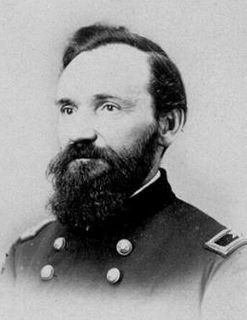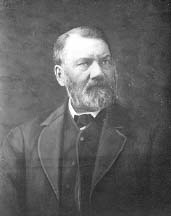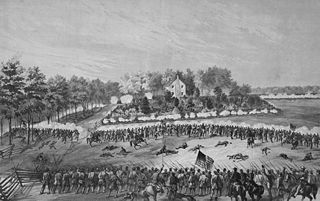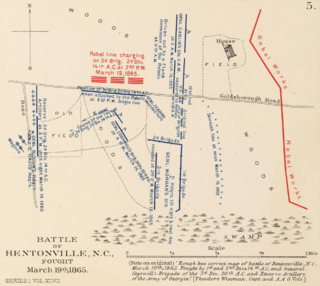
The Siege of Vicksburg was the final major military action in the Vicksburg Campaign of the American Civil War. In a series of maneuvers, Union Maj. Gen. Ulysses S. Grant and his Army of the Tennessee crossed the Mississippi River and drove the Confederate Army of Mississippi, led by Lt. Gen. John C. Pemberton, into the defensive lines surrounding the fortress city of Vicksburg, Mississippi.

The Army of the Tennessee was a Union army in the Western Theater of the American Civil War, named for the Tennessee River. It should not be confused with the similarly named Army of Tennessee, a Confederate army named after the State of Tennessee.

The Battle of Resaca was part of the Atlanta Campaign of the American Civil War. The battle was waged in both Gordon and Whitfield counties, Georgia, May 13–15, 1864. It ended inconclusively with the Confederate Army retreating. The engagement was fought between the Military Division of the Mississippi on the side of the Union and the Army of Tennessee for the Confederates.
Army of the Mississippi was the name given to two Union armies that operated around the Mississippi River, both with short existences, during the American Civil War.
The XVI Army Corps was a corps of the Union Army during the American Civil War. The corps rarely fought as one unified unit, as its divisions were often scattered across the country.

Morgan Lewis Smith was a Union brigadier general in the American Civil War

The Siege of Corinth was an American Civil War engagement lasting from April 29 to May 30, 1862, in Corinth, Mississippi. A collection of Union forces under the overall command of Major General Henry Halleck engaged in a month-long siege of the city, whose Confederate occupants were commanded by General P.G.T. Beauregard. The siege resulted in the capture of the town by Federal forces.
The Battle of Port Gibson was fought near Port Gibson, Mississippi, on May 1, 1863, between Union and Confederate forces during the Vicksburg Campaign of the American Civil War. The Union Army was led by Maj. Gen. Ulysses S. Grant, and was victorious.
The Meridian Campaign or Meridian Expedition took place from February 3 – March 6, 1864, from Vicksburg, Mississippi to Meridian, Mississippi, by the Union Army of the Tennessee, led by Maj. Gen. William Tecumseh Sherman. Sherman captured Meridian, Mississippi, inflicting heavy damage to it. The campaign is viewed by historians as a prelude to Sherman's March to the Sea in that a large swath of damage and destruction was inflicted on Central Mississippi as Sherman marched across the state and back.

The Battle of Chickasaw Bayou, also called the Battle of Walnut Hills, fought December 26–29, 1862, was the opening engagement of the Vicksburg Campaign during the American Civil War. Confederate forces under Lt. Gen. John C. Pemberton repulsed an advance by Union Maj. Gen. William T. Sherman that was intended to lead to the capture of Vicksburg, Mississippi.

Thomas Kilby Smith was a lawyer, soldier, and diplomat from the state of Ohio who served as a general in the Union Army during the American Civil War and then in the postbellum United States Army. He led a brigade and then a division in the Army of the Tennessee in several of the most significant campaigns of the Western Theater of operations before failing health forced him to a series of desk jobs.

Benjamin Franklin Potts was a lawyer, politician, and soldier from the state of Ohio who served as a general in the Union Army during the American Civil War, as well as a postbellum Governor of the Montana Territory from 1870 to 1883. He commanded a brigade of infantry in the Western Theater in some of the war's most important campaigns and repeatedly received commendations for gallantry and tactical judgement in combat.
Isaac Campbell Pugh was a United States volunteer soldier who was a veteran of the Black Hawk War, the Mexican–American War and the American Civil War; rising to the rank of Brevet brigadier general.

John Eugene Smith (1816-1897) was a Swiss immigrant to the United States, who served as a Union general during the American Civil War.

The 48th Regiment Indiana Infantry was an infantry regiment that served in the Union Army during the American Civil War.
The 53rd Regiment Indiana Infantry was an infantry regiment that served in the Union Army during the American Civil War.
























